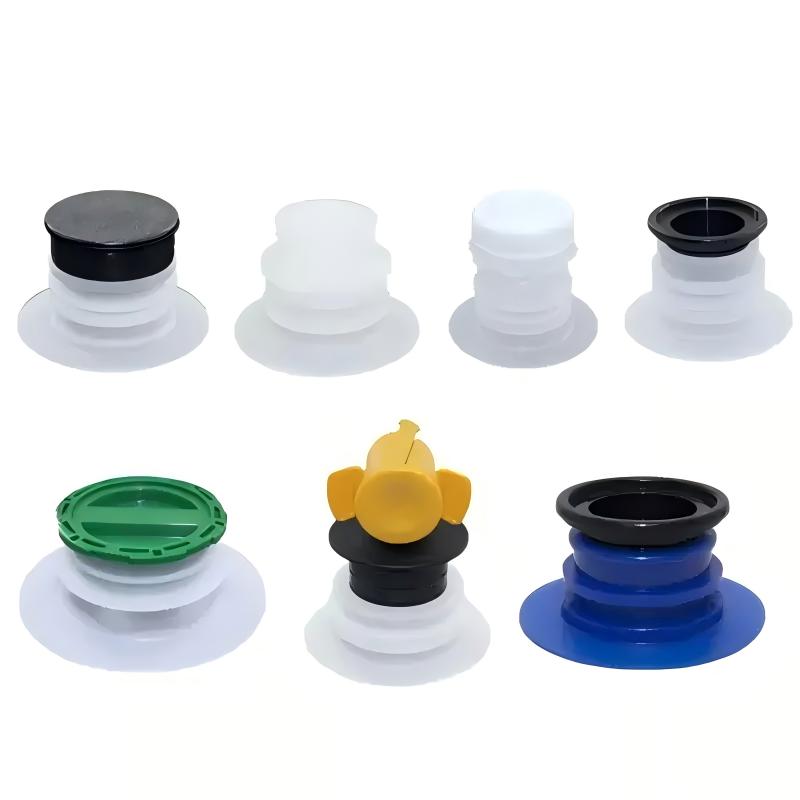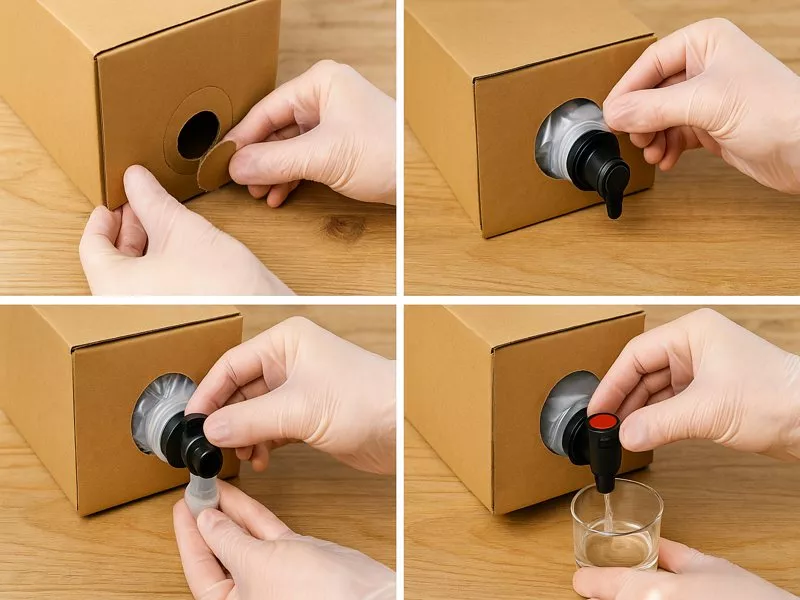Bag-in-Box (BiB) packaging has become one of the most reliable solutions for dispensing beverages like wine, juice, syrups, tea, and even cold brew coffee. At the heart of its convenience is the tap—a small but critical component that ensures beverages flow smoothly while maintaining freshness and preventing contamination. Whether you’re a homeowner using BiB for family gatherings, a restaurateur running high-volume soda dispensers, or a winery managing customer packaging, knowing how to properly install and replace a Bag-in-Box tap is essential.
This guide walks through everything you need to know: tap types, installation steps, replacement procedures, troubleshooting tips, and best practices for handling.

Why the Bag-in-Box Tap Matters
The tap may look like a simple plastic spigot, but it plays a vital role:
- Freshness Protection – The tap prevents oxygen from entering the bag, minimizing oxidation and keeping drinks flavorful for weeks.
- Controlled Dispensing – A properly fitted tap avoids drips, leaks, or splashes, ensuring neat self-service.
- Food Safety – High-quality taps are tamper-evident and designed to keep beverages safe from contaminants.
- User Convenience – Guests, staff, or family members can easily pour drinks without special tools.
A poorly installed or damaged tap, however, can lead to wasted product, leaks, or unsafe consumption. That’s why careful installation and timely replacement are so important.
Types of Bag-in-Box Taps
Before we jump into installation, let’s understand the most common tap styles:
Vitop Tap (Push-Button Style)
- Widely used in wines, juices, and premium beverages.
- Features a push-button or quarter-turn spout.
- Known for leak-proof performance and ease of use.
Butterfly-Type or Flip-Type Tap
- Flips upward or downward to allow opening and closing.
- Often used for syrups or concentrates in foodservice.
Screw-Cap Fitment + Tap Adapter
- Some BiBs use a screw-cap fitment that requires an external adapter.
- Common in soda syrup boxes for restaurants.
Pull-Ring Taps
- Less common today, but still used in some bulk juice applications.
- Requires pulling a small ring or lever to dispense.
- While installation steps are similar across types, knowing your specific tap ensures the best results.
Tools & Preparation
You don’t need heavy equipment, but having the right setup makes the job smoother.
Tools and materials:
- Clean, dry hands (or food-grade gloves in professional settings)
- Scissors or box cutter (to open carton perforation)
- Clean towel or tray (to catch any first drips)
- Replacement tap (if changing out an old one)
Preparation steps:
- Place the Bag-in-Box on a stable, flat surface.
- Identify the perforated cut-out on the carton (usually marked).
- Confirm beverage type and expiration date before installation.
- If replacing a tap, make sure the replacement matches the fitment style.

Step-by-Step: Installing a Bag-in-Box Tap
Step 1: Expose the Fitment
- Locate the perforated panel on the outer carton.
- Push in or cut neatly around the panel to reveal the bag’s fitment (usually capped).
- Be careful not to cut the bag itself.
Step 2: Remove Protective Cap
- Most BiB bags are sealed with a tamper-evident cap.
- Grip firmly and twist counterclockwise to remove.
- Keep a towel handy in case of a small pressure release.
Step 3: Insert the Tap
- Align the tap with the bag’s fitment.
- Push down firmly until you hear or feel a “click” (Vitop) or the tap locks into place.
- For butterfly taps, ensure the flat side faces outward for easy use.
Step 4: Seat Tap Through Carton Opening
- Pull or guide the tap spout through the carton perforation.
- Ensure the tap sits snugly—loose taps cause leaks and make pouring awkward.
Step 5: Test Dispense
- Place a cup under the spout.
- Gently press or turn to release a small amount.
- Confirm smooth flow and check for leaks.
Step-by-Step: Replacing a Bag-in-Box Tap
Taps sometimes need replacement due to wear, clogging, or accidental damage. Here’s how to do it safely.
Step 1: Stop Dispensing & Prepare
- Place the BiB on a flat, stable surface.
- If the beverage is perishable, move quickly to minimize oxygen exposure.
Step 2: Remove the Old Tap
- Pull the old tap out of the fitment.
- For Vitop and similar taps, grip firmly and twist slightly while pulling.
- Use a towel to catch any drips.
Step 3: Inspect the Fitment
- Check the bag’s fitment for cracks, debris, or damage.
- If the fitment itself is compromised, replacing the bag may be safer.
Step 4: Install the New Tap
- Insert the new tap as described in the installation steps.
- Ensure it clicks/locks in place.
Step 5: Flush & Test
- Dispense a small amount to flush out any air or loose particles.
- Confirm a tight seal and smooth flow.
Best Practices for Bag-in-Box Tap Handling
Always Keep It Clean
- Avoid touching the spout or inside surfaces with bare hands.
- In foodservice, sanitize the spout with alcohol wipes daily.
Store Properly
- Keep BiBs upright or on their sides as intended by design.
- Avoid stacking heavy objects on top.
Temperature Control
- Store perishable beverages at ≤ 41°F (5°C).
- Do not leave BiBs in hot vehicles or direct sun.
Gentle Operation
- Train users (especially kids) to press gently, not yank.
- Over-forced taps can crack the fitment or cause leaks.
Check Before Events
- Always test the tap before a big gathering or service shift.
- Early detection of leaks prevents messes later.
Troubleshooting Common Tap Issues
| Problem | Likely Cause | Solution |
| Slow flow | Bag not vented inside box / kinked bag | Adjust the box angle, straighten the bag |
| Leaking at base | Tap not fully seated | Remove and reinstall firmly |
| Dripping after use | Residual drops on spout | Keep drip tray, close tap tightly |
| Tap won’t insert | Wrong size/type | Verify compatibility before replacement |
| Beverage tastes off | Oxidation due to damaged tap | Replace tap or bag immediately |
Safety Considerations
- Single-use caution: Most taps are designed for one-time use. Reusing can compromise hygiene and seal integrity.
- Perishable beverages: If a tap fails on milk, juice, or coffee, discard the product if safety is uncertain.
- Children: Supervise young kids when dispensing to prevent spills or rough handling.
When to Replace the Entire Bag (Not Just the Tap)
Sometimes the issue isn’t the tap but the bag itself. Replace the whole BiB if:
- The bag is visibly punctured or leaking.
- The fitment is cracked or warped.
- The beverage has exceeded its shelf life.
- Mold, unusual odor, or sediment is visible.
Benefits of Proper Installation & Replacement
- Extended freshness: Proper sealing minimizes oxygen exposure.
- Reduced waste: Fewer leaks and less spillage mean better cost control.
- Happier guests/customers: Smooth, drip-free dispensing makes a strong impression.
- Operational efficiency: Staff spend less time cleaning and troubleshooting.
Real-World Applications of Bag-in-Box Taps
1) At Home
Families use BiB wines, juices, and teas for barbecues, birthdays, and road trips. Installing taps correctly ensures kids can serve safely without spills.
2) Restaurants & Cafés
From soda syrups in fast-food outlets to cold brew in coffee shops, taps must be installed daily for reliable dispensing. A misstep could disrupt service.
3) Wineries & Breweries
Many small wineries sell BiB wine for eco-friendly and long-lasting storage. Correct tap function reassures customers of quality.
4) Catered Events
Weddings, festivals, and corporate functions rely on BiB taps for quick, consistent service. Proper tap handling prevents embarrassing beverage station failures.
Sustainable Perspectives: Water Taps and the Environment
- Environmental Impact: Bag-in-Box packaging cuts down on waste compared to traditional bottles and cans. But the tap is also part of the equation:
- Material efficiency: Modern taps use less plastic per liter dispensed than bottle caps and necks.
- Extended shelf life: Less wasted beverage equals lower environmental impact.
- End-of-life recycling: While bags and taps are usually mixed plastics, outer cartons are widely recyclable. Some companies are piloting recyclable taps to further green the cycle.
Final Thoughts
Installing and replacing a Bag-in-Box tap might seem simple, but it’s a skill worth mastering. The tap is the gateway between your beverage and your glass, controlling freshness, safety, and user experience. By following correct installation steps, replacing taps when needed, and practicing good hygiene, you ensure that every pour—from a child’s lemonade to a café’s cold brew—stays as clean and delicious as intended.
Next time you host a family gathering, set up a catering station, or stock your restaurant beverage lines, remember: a well-installed tap isn’t just a detail—it’s the secret to smooth service and satisfied smiles.
